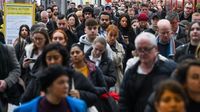Britain’s labor market is showing clear signs of cooling, as a series of new figures released by the Office for National Statistics (ONS) paint a picture of slowing job growth, cautious employers, and persistent economic headwinds. Between May and July 2025, job vacancies dropped by 5.8% to 718,000, marking the lowest level since April 2021. Outside the extraordinary circumstances of the pandemic, it’s a figure not seen since January 2015. The ONS attributes this widespread decline to nearly all industries, with the sharpest drops in hospitality and retail—sectors that have long been bellwethers for broader economic health.
"The number of employees on payroll has now fallen in 10 of the last 12 months, with these falls concentrated in hospitality and retail. Job vacancies, likewise, have continued to fall, also driven by fewer opportunities in these industries," Liz McKeown, director of economic statistics at the ONS, told BBC News.
That sentiment is echoed in the numbers. Payroll employment dropped by 8,000 in July 2025, and initial estimates indicate that the number of payrolled employees slipped between April and June, with the steepest declines in the hospitality and retail sectors. Over the year to June, payroll employment fell by 149,000, and preliminary figures for July suggest a further monthly decline of 8,000, with an annual drop of 164,000. The unemployment rate, meanwhile, held steady at 4.7%—the highest in four years.
Despite the cooling, the slowdown hasn’t been as dramatic as some economists feared. Average wage growth remained at 5% as of mid-2025, and firms giving notice of redundancies was "relatively subdued" in July, according to Ashley Webb, UK economist for Capital Economics. "The modest fall in payroll data suggests that the fallout in the jobs market from the rise in business taxes and the minimum wage is calming down," Webb said.
Still, the overall picture is one of caution. Businesses, particularly in hospitality and retail, are avoiding new hires due to rising labor costs, including the April 2025 National Living Wage increase—from £11.44 to £12.21—and a hike in employer National Insurance Contributions from 13.5% to 15%. The salary threshold triggering employer contributions was also lowered from £9,100 to £5,000 per year. These changes, introduced as part of last year’s autumn budget, have made profitability a challenge for many employers.
Louise Maclean, business development director at Scottish hospitality firm Signature Group, described the impact to BBC Radio 4: "We are having to be so careful with every hour of employment we give to make sure we improve efficiencies, serve customers faster, serve them better, to deliver profitability in every hour of trade." She noted that the company is now more likely to hire experienced workers over younger, less-experienced candidates, as "slightly older people that have got experience, that can hit the ground running—they know what the customers want, are more attractive."
On the policy front, the Bank of England’s Monetary Policy Committee (MPC) cut interest rates to 4% in August 2025—a move designed to support growth amid the labor market’s fragility. The decision was a close one, with the MPC voting 5-4 in favor. The Bank projects inflation to peak at 4% in September 2025 and then gradually decline to its 2% target by mid-2027. However, services inflation remains stubbornly high at 4.7%, and core inflation sits at 3.7%, driven by annual pricing cycles and lingering cost-of-living pressures. The MPC’s next decision is scheduled for September 18, 2025, with further cuts dependent on disinflationary trends and global economic stability.
Public-sector wage growth has outpaced the private sector, coming in at 5.5% compared to 4.9%, but after adjusting for inflation—currently at 3.6%—real wage growth remains muted at just 1.7%. This dynamic puts workers in a bind: pay packets are rising, but not enough to outpace the cost of living, leaving real incomes relatively stagnant.
Chancellor Rachel Reeves acknowledged the mixed signals in the jobs data, telling reporters there was "some really positive news" but also "more to do" to reduce the unemployment rate. "Everybody who can work should be in work. As a government, we're committed to helping more people back to work," she said. The opposition, however, was quick to pounce. Helen Whately, shadow work and pensions secretary, criticized the government’s approach, arguing that the unemployment rate was the "sad but predictable outcome of Labour's war on business—which has seen taxes hiked to record highs and employers strangled in reams of red tape."
For businesses, the new labor landscape means a focus on efficiency and careful hiring. As Monica George Michail, associate economist at the National Institute of Economic and Social Research, told BBC News, the fall in job vacancies is likely to contribute to slowing wage growth—one of the key indicators the Bank of England watches when setting interest rates. She predicted the Bank would cut rates one more time this year, forecasting borrowing costs to fall from 4% to 3.75% in November.
In the wider economy, the effects of these labor market dynamics are playing out across sectors. According to AInvest, lower borrowing costs have buoyed housing and energy companies. Construction firms like Taylor Wimpey saw shares rise 8% in August 2025, while Harbour Energy’s stock surged 14% after a share buyback and upbeat production guidance. Yet, not all sectors are so lucky. Geopolitical tensions and trade disruptions have hit defense and materials companies, with Babcock International and BAE Systems seeing sharp declines.
Retailers, meanwhile, face a tricky balancing act. July’s retail sales figures showed a 2.5% year-on-year rise—better than the 12-month average—but much of that growth is inflation-fueled rather than driven by increased volume. "If economic growth stalls and taxes rise, the consumer could face more pressure, which would weigh on spending," warned Shore Capital’s Clive Black, as reported by Evening Standard. Food sales led the way, but ongoing labor, energy, and business costs continue to squeeze margins.
Financial services have seen a mixed picture. Vanquis Banking posted a 12% gain in August, reflecting adaptability to the new rate environment, while traditional banks like Barclays experienced modest declines amid economic uncertainty.
With the FTSE 100 index up 10 points at 9,139.84 on August 12, 2025, and global market sentiment subdued, investors are treading carefully. Sectors aligned with structural demand—housing, energy, and infrastructure—offer some resilience, but overexposure to cyclical sectors remains risky given the uncertain macroeconomic outlook.
As the UK labor market continues to cool and the Bank of England walks a tightrope on monetary policy, both employers and workers are adjusting to a new reality. For now, patience and adaptability seem to be the watchwords. With inflation still a drag and wage growth under pressure, the coming months will be critical in determining whether the UK economy can regain its footing or faces a longer, bumpier road ahead.







